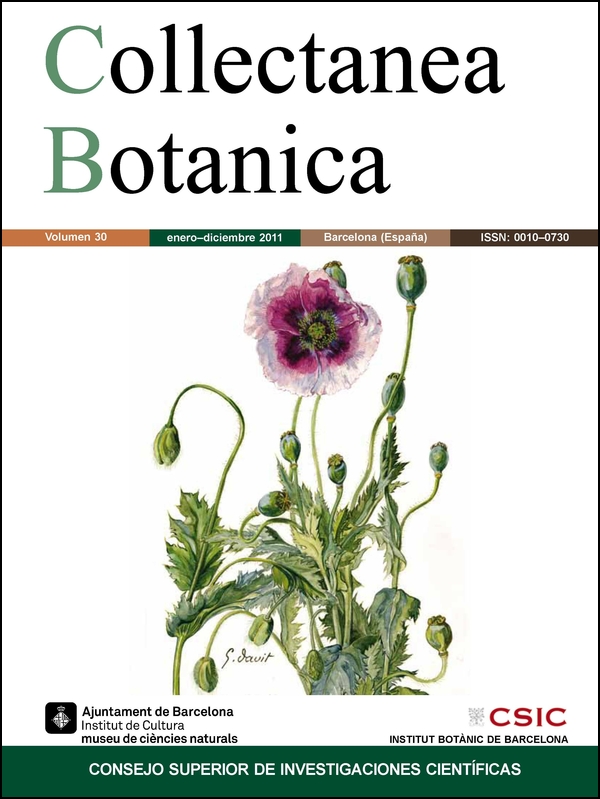First record of the alien pest Rhaponticum repens (Compositae) in the Iberian Peninsula
DOI:
https://doi.org/10.3989/collectbot.2011.v30.006Keywords:
Alien species, Compositae, Iberian PeninsulaAbstract
First record of the alien pest Rhaponticum repens (Compositae) in the Iberian Peninsula.- Rhaponticum repens is reported for the first time for the flora of the Iberian Peninsula. The species is native from Central Asia and has become invasive in Argentina, Canada, Europe and the USA. It was detected for the first time in abandoned fields from Vilablareix, near the city of Girona (Catalonia, Spain) and in the valley of the Vinalopó in Alicante (Valencia, Spain), where it was collected as early as in 1959 but misdentified. Molecular data, based on nrDNA region ITS, suggest that the reported populations may be closely related to plants from the United States. Due to the extremely noxious character of the species and the possible relationship of Spanish plants with the invasive American populations, some kind of monitoring is recommended.
Downloads
References
Bezic, C., Sabbatini, M. R. & Dall’Armellina, A. 2006/07. Estatus y conflictos frente al proceso de invasión de Yuyo moro (Acroptilon repens (L.) DC.) en el valle inferior de Río Negro. Pilquen. Sección Agronomía 8: 2.
Dittrich, M. 1977. Cynareae – systematic review. In: Heywood, V. H., Harborne, J. B. & Turner, B. L. (Eds.), The biology and chemistry of the Compositae. Academic Press, London: 999-1015.
Duncan, R. P., Blackburn, T. M. & Sol, D. 2003. The ecology of bird introductions. Annual Rev. Ecol. Evol. Syst. 34: 71-98. http://dx.doi.org/10.1146/annurev.ecolsys.34.011802.132353
Garcia-Jacas, N., Uysal, T., Romashchenko, K., Suárez-Santiago, V. N., Ertu?rul, K. & Susanna, A. 2006. Centaurea revisited: A molecular survey of the Jacea group. Ann. Bot. (Oxford) 98: 741-753.
Grant, D. W., Peters, D. P. C., Beck, G. K. & Fraleigh, H. D. 2003. Influence of an exotic species, Acroptilon repens (L.) DC. on seedling emergence and growth of native grasses. Pl. Ecol. 166: 157-166. http://dx.doi.org/10.1023/A:1023221024593
Hall, T. A. 1999. BioEdit: a user-friendly biological sequence alignment editor and analysis program for Windows 95/98/ NT. Nucl. Acids Symp. Series 41: 95-98.
Hidalgo, O., Garcia-Jacas, N., Garnatje, T. & Susanna, A. 2006. Phylogeny of Rhaponticum (Asteraceae, Cardueae–Centaureinae) and related genera inferred from nuclear and chloroplast DNA sequence data: Taxonomic and biogeographic implications. Ann. Bot. (Oxford) 97: 705-714. http://dx.doi.org/10.1093/aob/mcl029 PMid:16495316 PMCid:2803413
Moore, R. J. & Frankton, C. 1974. The thistles of Canada. Research Branch, Canada Department of Agriculture, Ottawa. Rivas Martínez, S. 2007. Mapa de series, geoseries y geopermaseries de vegetación de España. Memoria del mapa de vegetación potencial de España. Parte 1. Itin. Geobot. 17: 1-435.
Sun, Y., Skinner, D. Z., Liang, G. H. & Hulbert, S. H. 1994. Phylogenetic analysis of Sorghum and related taxa using internal transcribed spacers of nuclear ribosomal DNA. Theor. Appl. Genet. 89: 26-32. http://dx.doi.org/10.1007/BF00226978
Watson, A. K. 1980. The biology of Canadian weeds. 43. Acroptilon (Centaurea) repens (L.) DC. Canad. J. Pl. Sci. 60: 993-1004. http://dx.doi.org/10.4141/cjps80-142
Downloads
Published
How to Cite
Issue
Section
License
Copyright (c) 2011 Consejo Superior de Investigaciones Científicas (CSIC)

This work is licensed under a Creative Commons Attribution 4.0 International License.
© CSIC. Manuscripts published in both the print and online versions of this journal are the property of the Consejo Superior de Investigaciones Científicas, and quoting this source is a requirement for any partial or full reproduction.
All contents of this electronic edition, except where otherwise noted, are distributed under a Creative Commons Attribution 4.0 International (CC BY 4.0) licence. You may read the basic information and the legal text of the licence. The indication of the CC BY 4.0 licence must be expressly stated in this way when necessary.
Self-archiving in repositories, personal webpages or similar, of any version other than the final version of the work produced by the publisher, is not allowed.














